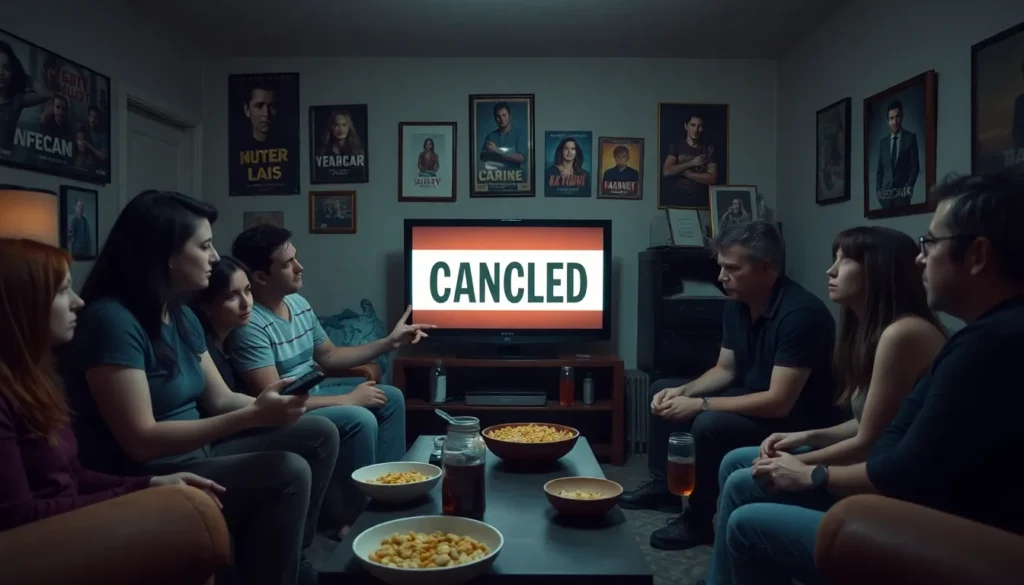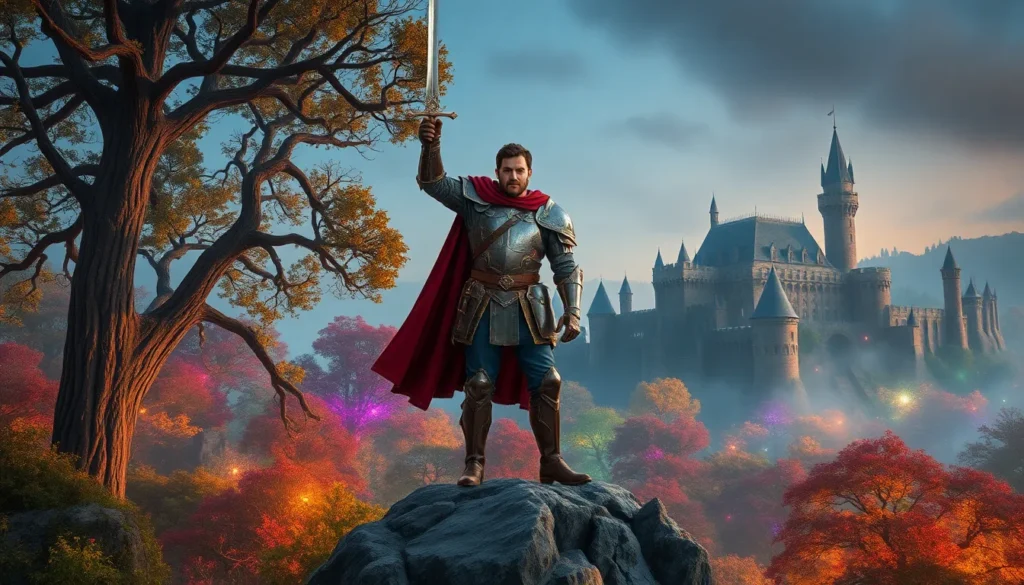Table of Contents
ToggleIn the world of television, few things sting quite like a show cancellation. One moment, viewers are glued to their screens, engrossed in gripping plots and unforgettable characters. The next, they’re left staring at the credits, wondering why their favorite show got the axe. It’s like being dumped by a partner who promised to love you forever—only to realize they were just in it for the ratings.
As networks shuffle their lineups and chase fleeting trends, beloved series often find themselves on the chopping block. Fans rally, petitions circulate, and social media explodes with outrage. Yet, the cold reality is that not every show can survive the cutthroat world of TV. So, what makes a show worthy of renewal, and what leads to its untimely demise? Buckle up as we dive into the rollercoaster ride of TV show cancellations, where laughter and heartbreak go hand in hand.
Overview of TV Show Cancellations
TV show cancellations create significant emotional responses among viewers. Networks often make these decisions based on complex factors, such as audience ratings, production costs, and shifting demographics. Trends in viewing habits heavily influence a series’ future, with streaming platforms increasingly changing the landscape.
Ratings data serves as a pivotal metric; shows that fail to capture enough viewers face the risk of cancellation. Additionally, networks analyze audience engagement through social media, spotlighting viewer reactions and discussions. This multifaceted evaluation helps determine whether a series continues.
Production costs impact decisions as well. High-budget shows require substantial viewership to remain viable. If a show’s production does not align with its audience retention, the network might choose to cancel it.
Involving fans in the conversation can also lead to unexpected outcomes. Shows with dedicated followings sometimes manage to rally support that leads networks to reconsider cancellations. Social media campaigns, fan petitions, and even influencer endorsements can make a difference.
Ultimately, a combination of creative vision, financial realities, and cultural relevance dictates the fate of a show. Many beloved series face premature endings, leaving fans longing for closure. Understanding these dynamics reveals the difficult choices networks confront in an ever-evolving media landscape.
Common Reasons for Cancellations

Television show cancellations stem from various factors affecting networks, producers, and audiences alike. Here are some common reasons that lead to such decisions.
Ratings and Viewership
Ratings and viewership numbers play a pivotal role in determining a show’s fate. Shows that fail to garner a substantial audience often face cancellation. Networks rely on Nielsen ratings to gauge a program’s popularity, assessing whether it’s attracting enough viewers. Low ratings signal a lack of interest, prompting networks to re-evaluate their programming. Audience engagement metrics provide additional insight; for instance, social media activity can demonstrate a show’s reach beyond traditional viewership. Shows that resonate deeply with their audiences can sometimes defy low ratings, indicating a potential for growth.
Network Decisions
Network decisions heavily influence the future of TV shows. Financial considerations frequently guide these choices, with networks prioritizing content that aligns with their strategic goals. Factors like advertising revenue and production budgets create a delicate balance that networks must maintain. Sometimes, networks opt for a safer bet, favoring familiar formats over new content. Additionally, shifts in strategies, such as prioritizing streaming services, can lead to abrupt cancellations. Internal assessments, team feedback, and long-term goals contribute to the decision-making process as well.
Creative Differences
Creative differences can significantly impact the longevity of a television show. Conflicts between showrunners, writers, and networks often arise regarding the direction of a series. Disagreements over storylines, character development, or overall vision can derail a project. Networks may discontinue shows that do not align with their creative goals, even if they have decent ratings. Show creators may also seek to pursue other opportunities, leading to unsatisfying conclusions for ongoing series. The interplay between artistic intent and commercial viability often defines whether a show continues or faces cancellation.
Impact on Fans and Communities
TV show cancellations significantly affect fans and their communities, evoking strong emotional responses and inspiring action among viewers.
Emotional Reactions
Fans often express deep sadness and frustration when a favorite show gets canceled. Losing a series can feel akin to losing a cherished connection. Viewers invest time and emotion into storylines and characters, forging a bond that continues beyond the screen. Grieving the abrupt loss of that connection leads to feelings of betrayal when networks decide to cancel shows without proper closure. Many people turn to social media to share their feelings, creating a palpable sense of community among fellow supporters as they navigate the shared experience of mourning their lost series.
Fan Movements and Campaigns
Fans frequently mobilize in response to cancellations, initiating campaigns to save their beloved shows. Petitions circulate online, gathering signatures to demonstrate viewer demand. Social media platforms host discussions that can influence network decisions, amplifying voices that might otherwise go unheard. Fans organize rallies and create hashtags, gaining media attention to support their cause. Some campaigns have proven successful, leading networks to reconsider cancellations based on evident enthusiasm from dedicated viewers. These efforts highlight the powerful role fan involvement plays in shaping the future of television programming.
Notable TV Show Cancellations
Numerous TV shows faced abrupt endings, leaving fans disheartened. These cancellations often grab headlines, creating significant buzz in the entertainment industry.
Highly Publicized Cases
Game of Thrones stood out as one of the most talked-about cancellations. Though not technically canceled, the series concluded in 2019, sparking intense debate over its final season. Fans rallied online, expressing their disappointment over character arcs and plot resolutions. Similarly, the abrupt end of shows like Santa Clarita Diet and The Expanse generated buzz. Viewers launched campaigns to save them, demonstrating strong fan passion. Their efforts illustrate how deeply invested audiences remain in their favorite series, amplifying the emotional toll of these decisions.
Cult Favorites and Their Impact
Cult classics often face the grim fate of cancellation despite dedicated followings. Shows like Firefly and Freaks and Geeks endured short runs but left lasting impressions. Devoted fans created loyal communities, keeping conversations alive long after cancellation. These series inspired movements and even successful revivals, as in the case of Firefly with its movie, Serenity. Dedicated fan bases mobilized to show networks the value of niche programming. Cult favorites emphasize the potential for viewer engagement to shape television history, prompting networks to reconsider their programming decisions.
The Future of TV Shows
The landscape of TV shows continues to evolve, shaped by viewer preferences and market dynamics.
Trends in Renewals and Cancellations
Ratings play a crucial role in determining a show’s fate. Advertisers seek high viewership numbers, prompting networks to reconsider underperforming shows. Shifting audience insatiability influences renewal decisions, as fan engagement becomes increasingly important. Networks also evaluate critical reception; shows with strong critiques often receive second chances. Viewer demographics reflect changing tastes, creating pressure to adapt content accordingly. Social media buzz can sway decisions, amplifying fan voices and campaigns to save shows. Budget restraints push networks to focus on profitable programs, solidifying the connection between financial health and renewal rates.
Streaming Services and Their Role
Streaming services have redefined the television landscape dramatically. New platforms prioritize niche content, catering to diverse audience interests. Original programming from services like Netflix and Amazon showcases shows that traditional networks may overlook. Binge-watching encourages viewers to engage with series differently, improving retention rates. Data analytics enable platforms to gauge viewer trends more effectively, informing renewal strategies. The competition for viewership among services also drives innovation, leading to more creative storytelling. Ultimately, streaming platforms influence both cancellations and renewals, reshaping the industry’s future significantly.
The world of TV show cancellations remains a complex and often heartbreaking reality for fans. Each cancellation not only ends a beloved story but also disrupts the community built around it. Viewers invest emotionally in these narratives and characters, making abrupt endings feel like personal losses.
As the television landscape evolves with streaming platforms and changing viewer habits, the dynamics of renewal and cancellation will continue to shift. Fans have shown their power through campaigns and petitions, proving that their voices can impact decisions. Ultimately, the fate of a show reflects a blend of creative ambition, financial constraints, and audience engagement, leaving many to wonder what might have been.




